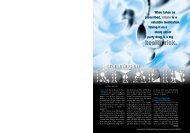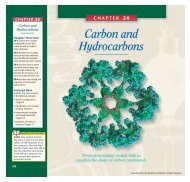You also want an ePaper? Increase the reach of your titles
YUMPU automatically turns print PDFs into web optimized ePapers that Google loves.
9 REVIEW & ASSESS<br />
12. because the pressure the grains<br />
exert increases <strong>with</strong> increasing<br />
depth<br />
13. 20 m deep, because pressure<br />
increases <strong>with</strong> increasing<br />
depth<br />
14. a. Molecules are moving faster,<br />
so the particles collide<br />
more often and, in the<br />
absence of any other force,<br />
push each other outward.<br />
b. As particles move about in<br />
a gas, they exert a force<br />
F<br />
⎯) on the walls of the<br />
(P = ⎯ A<br />
container.<br />
15. No, there would be no way to<br />
get the pressure in your mouth<br />
lower than the zero atmospheric<br />
pressure outside the liquid.<br />
16. 1.9 × 10 4 N<br />
17. 6.28 N<br />
18. 14 N downward<br />
19. a. 2.61 × 10 6 Pa<br />
b. 1.84 × 10 5 N<br />
20. The air flow causes the pressure<br />
over the entrance in the<br />
mound to be lower than the<br />
pressure over the other<br />
entrance. Thus, air is pushed<br />
through the mound by the<br />
higher-pressure area.<br />
21. The water on the first floor has<br />
only kinetic energy (⎯ 1<br />
2 ⎯ rv 1 2 ),<br />
whereas the water on the second<br />
floor has both kinetic and<br />
potential energy (⎯ 1<br />
2 ⎯ rv 2 2 + rgh).<br />
Thus, because energy is conserved,<br />
v 1 > v 2.<br />
22. The moving air above the ball<br />
creates a low pressure area so<br />
that the air below the ball<br />
exerts a force that is equal and<br />
opposite F g.<br />
23. 2.4 m/s<br />
24. 12.6 m/s<br />
25. Pressure decreases, so volume<br />
increases.<br />
344<br />
Practice problems<br />
16. The four tires of an automobile are inflated to an<br />
absolute pressure of 2.0 × 10 5 Pa. Each tire has an<br />
area of 0.024 m 2 in contact <strong>with</strong> the ground. Determine<br />
the weight of the automobile.<br />
(See Sample Problem 9B.)<br />
17. A pipe contains water at 5.00 × 10 5 Pa above atmospheric<br />
pressure. If you patch a 4.00 mm diameter<br />
hole in the pipe <strong>with</strong> a piece of bubble gum, how<br />
much force must the gum be able to <strong>with</strong>stand?<br />
(See Sample Problem 9B.)<br />
18. A piston, A, has a diameter<br />
of 0.64 cm, as in<br />
Figure 9-19. A second<br />
piston, B, has a diameter<br />
of 3.8 cm. In the<br />
absence of friction,<br />
determine the force, F,<br />
necessary to support the<br />
500.0 N weight.<br />
(See Sample Problem 9B.)<br />
19. A submarine is at an ocean depth of 250 m.<br />
a. Calculate the absolute pressure at this<br />
depth. Assume that the density of water is<br />
1.025 × 10 3 kg/m 3 and that atmospheric pressure<br />
is 1.01 × 10 5 Pa.<br />
(See Sample Problem 9C.)<br />
b. Calculate the magnitude of the total force<br />
exerted at this depth on a circular submarine<br />
window <strong>with</strong> a diameter of 30.0 cm.<br />
(See Sample Problem 9B.)<br />
FLUID FLOW<br />
Conceptual questions<br />
20. Prairie dogs live in underground burrows <strong>with</strong> at<br />
least two entrances. They ventilate their burrows by<br />
building a mound around one entrance, which is<br />
open to a stream of air. A second entrance at ground<br />
level is open to almost stagnant air. Use Bernoulli’s<br />
principle to explain how this construction creates<br />
air flow through the burrow.<br />
344<br />
Chapter 9<br />
B<br />
500.0 N<br />
F<br />
A<br />
Figure 9-19<br />
21. Municipal water supplies are often provided by<br />
reservoirs built on high ground. Why does water<br />
from such a reservoir flow more rapidly out of a<br />
faucet on the ground floor of a building than out of<br />
an identical faucet on a higher floor?<br />
22. If air from a hair dryer is blown over the top of a<br />
table-tennis ball, the ball can be suspended in air.<br />
Explain how this suspension is possible.<br />
Practice problems<br />
23. A dairy farmer notices that a circular water trough<br />
near the barn has become rusty and now has a hole<br />
near the base. The hole is 0.30 m below the level of<br />
the water that is in the tank. If the top of the trough<br />
is open to the atmosphere, what is the speed of the<br />
water as it leaves the hole?<br />
(See Sample Problem 9D.)<br />
24. The hypodermic syringe shown in Figure 9-20 contains<br />
a medicine <strong>with</strong> the same density as water. The<br />
barrel of the syringe has a cross-sectional area of<br />
2.50 × 10 −5 m 2 . The cross-sectional area of the needle<br />
is 1.00 × 10 −8 m 2 . In the absence of a force on<br />
the plunger, the pressure everywhere is atmospheric<br />
pressure. A 2.00 N force is exerted on the plunger,<br />
making medicine squirt from the needle. Determine<br />
the speed of the emerging fluid. Assume that the<br />
pressure in the needle remains at atmospheric pressure,<br />
that the syringe is horizontal, and that the<br />
speed of the emerging fluid is the same as the speed<br />
of the fluid in the needle.<br />
(See Sample Problem 9D.)<br />
F<br />
P1<br />
A1<br />
Figure 9-20<br />
GASES AND THE IDEAL GAS LAW<br />
Conceptual questions<br />
25. Why do underwater bubbles grow as they rise?<br />
26. What happens to a helium-filled balloon released<br />
into the air? Does it expand or contract? Does it<br />
stop rising at some height?<br />
P2<br />
A2<br />
v2<br />
Copyright © by Holt, Rinehart and Winston. All rights reserved.
















